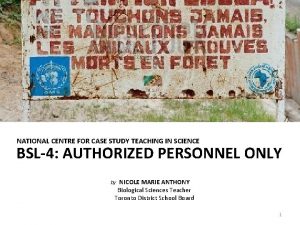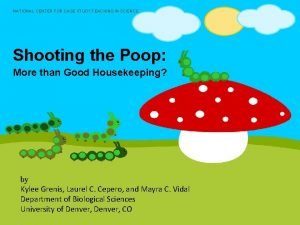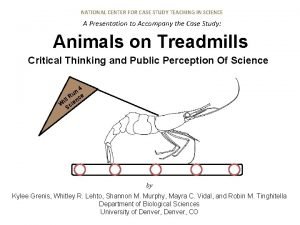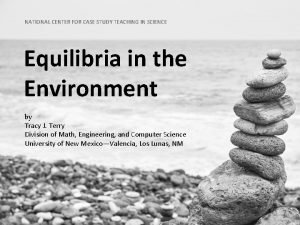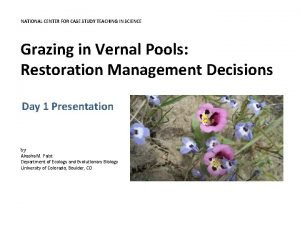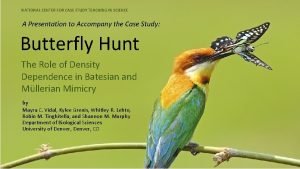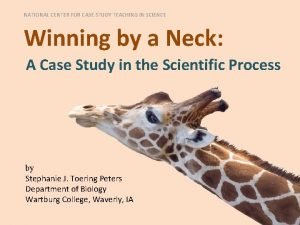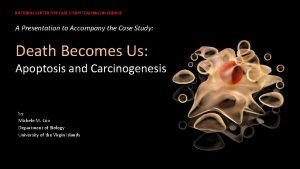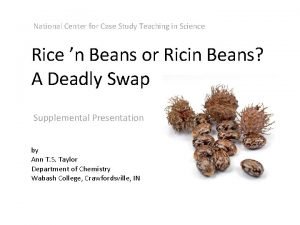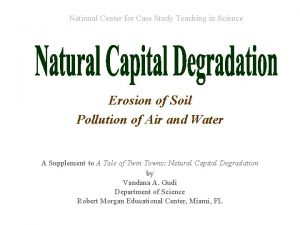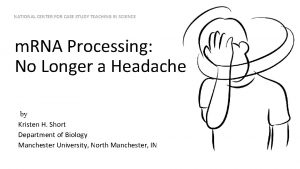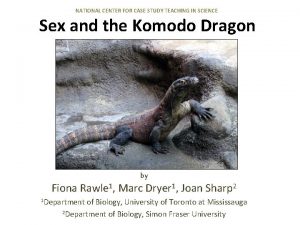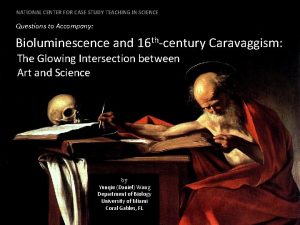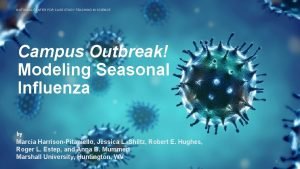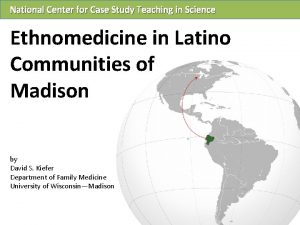NATIONAL CENTER FOR CASE STUDY TEACHING IN SCIENCE














- Slides: 14

NATIONAL CENTER FOR CASE STUDY TEACHING IN SCIENCE Equilibria in the Environment by Tracy J. Terry Division of Math, Engineering, and Computer Science University of New Mexico—Valencia, Los Lunas, NM

Part I – Bubble, Toil and Trouble 1. Read the experiment description: The 250 m. L beaker contains a small amount of p. H indicator in about 100 m. L of neutral water. A student will exhale into a straw to blow bubbles into the solution. Then, ambient air will be pumped through the solution. 2. Answer questions #1– 3 on the student handout. 3. Perform the experiment: First, blow bubbles through a straw into the solution. Note any p. H changes. Next, pump ambient air into the same solution. Note any p. H changes. 4. Answer questions #4– 6 on the student handout. 2

Extrapolate Develop a new hypothesis based on your information As the CO 2 concentration in the atmosphere increases… What do you think is happening to the p. H of the oceans? Answer question #7 on the student handout. 3 http: //www. physicalgeography. net/fundamentals/7 a. CO 2. html

Ocean Acidification: The Other Carbon Dioxide Problem “Fundamental changes in seawater chemistry are occurring throughout the world's oceans. Since the beginning of the industrial revolution, the release of carbon dioxide (CO 2) from humankind's industrial and agricultural activities has increased the amount of CO 2 in the atmosphere. The ocean absorbs about a quarter of the CO 2 we release into the atmosphere every year, so as atmospheric CO 2 levels increase, so do the levels in the ocean. Initially, many scientists focused on the benefits of the ocean removing this greenhouse gas from the atmosphere. However, decades of ocean observations now show that there is also a downside — the CO 2 absorbed by the ocean is changing the chemistry of the seawater, a process called OCEAN ACIDIFICATION. ” NOAA—PMEL Answer question #8 on the student handout. 4

Part II – Dissolution of Antacids 1. Read the experiment description: There are three beakers containing solutions of different p. H. Use a p. H meter or universal p. H indicator to determine the p. H for each solution. One antacid tablet will be added to each beaker. The active ingredient in the antacid tablet is calcium carbonate. p. H 2 p. H 7 p. H 10 2. Answer questions #1– 5 on the student handout. 3. Perform the experiment: Drop one antacid in each of the beakers. Observe the results. 4. Answer questions #6– 9 on the student handout. 5

Extrapolate Develop a new hypothesis based on your information Recap… • Increasing CO 2 concentrations in the atmosphere raises the H+ concentration in the ocean, lowering ocean p. H. [CO 2]atmosphere [H+]ocean p. Hocean • Lower p. H increases solubility of calcium carbonate. p. Hocean solubility Ca. CO 3 Given • Coral reefs are diverse underwater ecosystems held together by calcium carbonate structures secreted by corals. -WIkipedia • Shells of mollusks, such as oysters, are held together by calcium carbonate structural secretions. How is ocean acidification going to affect coral reefs and ocean 6 mollusks? Answer question #10 on the student handout.

http: //www. pmel. noaa. gov/co 2/story/Ocean+Acidification 7

In the news… • “Oregon State researchers trace oyster larvae die-off to increasing ocean acidity” – Headline of article from The Oregonian, April 13, 2012. • “Ocean acidification is the main suspect as some farms report mortality rates as high as 90%” – “Mystery surrounds massive die-off of oysters and scallops off of B. C. coast, ” The Globe and Mail, Feb 27, 2014. • “[T]he oyster [larvae] need to exert more energy for shell building and have less for swimming and getting food…these tiny oysters just sink in the water and stop swimming. ” – “Ocean acidification causing Pacific oyster die-off, ” Seeker, Dec 16, 2014. Answer question #11 on the student handout. 8

Ocean Acidification and Ca. CO 3 Saturation Watch: https: //sos. noaa. gov/Datasets/view-movie. html? video=ocean_acid_arag_400 9

Plankton - “Biological carbon pump” Phytoplankton consume as much CO 2 as land plants. Most of the CO 2 consumed by phytoplankton during photosynthesis is returned to nearsurface waters, but some falls into the ocean depths. “Even small changes in the growth of phytoplankton may affect atmospheric carbon dioxide concentrations…” 10

Effect of CO 2 on Plankton • • https: //earthobservatory. nasa. gov/features/Phytoplankton/page 1. php Graph adapted from Bopp 2005 by Robert Simmon. L. Bopp, et al. “Response of diatoms distribution to global warming and potential implications: A global model study, ” Geophysical Research Letters, 2005 The predominant form of phytoplankton in oceans are diatoms – single celled algae with silica shells Diatom populations are expected to decrease as CO 2 concentration increases http: //www. edc. uri. edu/restoration/html/gallery/plants/phyt o. htm • Foraminifera – an amoeba-like marine plankton with calcium carbonate shells • Foraminifera are predicted to be extinct by end of century due to decreased p. H of oceans – S. Uthicke, et al. , “High risk of extinction of benthic foraminifera in this century due to ocean acidification”, Scientific Reports, 3, 2013. By Psammophile - Microphotographie personnelle 11 BY-SA 3. 0, http: //www. arenophile. fr/Pages_IMG/P 2966 e. html, CC https: //commons. wikimedia. org/w/index. php? curid=20886081

Part III – Shell-lacked! 1. Read the experimental description Beaker A contains sea shells soaked overnight in tap water. Beaker B contains sea shells soaked overnight in vinegar (~4% acetic acid). 2. Answer questions #1– 5 on the student handout. Work through the scientific method on the student worksheet in order to develop a hypothesis and an experiment to test it. 3. Perform a new experiment. Propose experiments to the instructor. Perform a new experiment(s). 4. Answer questions #6– 8 on the student handout. 12

Homework Answer questions #9 -10 on the student handout. 9. Develop a hypothesis related to ocean acidification that applies to a broader situation than the one specifically tested during class. 10. Based on the information you have learned today, propose a method to slow or counter the process of ocean acidification. 13

References Atmospheric CO 2 http: //www. physicalgeography. net/fundamentals/7 a. CO 2. html Siple Station Ice Core Data Neftel, A. , H. Friedli, E. Moore, H. Lotscher, H. Oeschger, U. Siegenthaler, and B. Stauffer. 1994. Historical carbon dioxide record from the Siple Station ice core. pp. 11 -14. In T. A. Boden, D. P. Kaiser, R. J. Sepanski, and F. W. Stoss (eds. ) Trends'93: A Compendium of Data on Global Change. ORNL/CDIAC-65. Carbon Dioxide Information Analysis Center, Oak Ridge National Laboratory, Oak Ridge, Tenn. U. S. A. Mauna Loa Data Keeling, C. D. and T. P. Whorf. 2006. Atmospheric CO 2 records from sites in the SIO air sampling network. In Trends: A Compendium of Data on Global Change. Carbon Dioxide Information Analysis Center, Oak Ridge National Laboratory, U. S. Department of Energy, Oak Ridge, Tenn. , U. S. A. Ocean CO 2 and p. H http: //www. pmel. noaa. gov/co 2/story/Ocean+Acidification Heltzel, P. December 16, 2014. Ocean acidification causing Pacific oyster die-off. Seeker. <https: //www. seeker. com/ocean-acidification-causing-pacific-oyster-die-off-1769373751. html>. Hume, M. February 27, 2014. Mystery surrounds massive die-off of oysters and scallops off of B. C. coast. The Globe and Mail. <https: //www. theglobeandmail. com/news/british-columbia/mystery-surrounds-massive-die-off-of-oysters-andscallops-off-bc-coast/article 17156108/>. Tobias, L. April 13, 2012. Oregon State research traces oyster larvae die-off to increasing ocean acidity. The Oregonian. https: //www. oregonlive. com/pacific-northwest-news/2012/04/oregon_state_research_traces_o. html. Ca. CO 3 predictive video: https: //sos. noaa. gov/Datasets/view-movie. html? video=ocean_acid_arag_400 Phytoplankton https: //earthobservatory. nasa. gov/features/Phytoplankton Bopp, L. (2005). Response of diatoms distribution to global warming and potential implications: A global model study. Geophysical Research Letters, 32(L 19606). S. Uthicke, et al. , “High risk of extinction of benthic foraminifera in this century due to ocean acidification, ” Scientific Reports 3, 2013. http: //www. edc. uri. edu/restoration/html/gallery/plants/phyto. htm 14
 National centre for case study teaching in science
National centre for case study teaching in science National center for case study teaching in science
National center for case study teaching in science National center for case study teaching in science
National center for case study teaching in science National center for case study teaching in science answers
National center for case study teaching in science answers National center for case study teaching in science
National center for case study teaching in science National center for case study teaching in science
National center for case study teaching in science National center for case study teaching in science
National center for case study teaching in science Best case worst case average case
Best case worst case average case Foxmeyer erp failure case study
Foxmeyer erp failure case study Favorite subject is science
Favorite subject is science Differences between micro teaching and traditional teaching
Differences between micro teaching and traditional teaching Fspos vägledning för kontinuitetshantering
Fspos vägledning för kontinuitetshantering Novell typiska drag
Novell typiska drag Tack för att ni lyssnade bild
Tack för att ni lyssnade bild Vad står k.r.å.k.a.n för
Vad står k.r.å.k.a.n för
